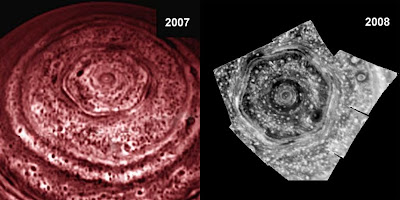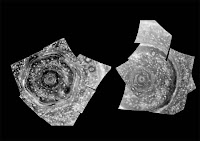 Estas são as imagens de alta resolução captadas pela Cassini nas missões de 2007 e 2008. Imagens do magnífico e misterioso padrão gravado nas nuvens em torno do pólo norte de Saturno. O hexágono (quase) perfeito é observado desde 1980 quando a sonda Voyager 1 passou pelo planeta, e o mesmo padrão ainda existe hoje, 28 anos depois. Portanto, trata-se de um padrão estável, que permanece inalterado mesmo quando grandes e poderosos ciclones fustigam as fronteiras do hexágono.
Estas são as imagens de alta resolução captadas pela Cassini nas missões de 2007 e 2008. Imagens do magnífico e misterioso padrão gravado nas nuvens em torno do pólo norte de Saturno. O hexágono (quase) perfeito é observado desde 1980 quando a sonda Voyager 1 passou pelo planeta, e o mesmo padrão ainda existe hoje, 28 anos depois. Portanto, trata-se de um padrão estável, que permanece inalterado mesmo quando grandes e poderosos ciclones fustigam as fronteiras do hexágono.
Saturno, o planeta do sistema solar mais bizarro e magnifico, fica assim ainda mais misterioso.Sonda vê misterioso hexágono em Saturno
Um estranho desenho em favo de mel circundando todo o pólo Norte de Saturno capturou o interesse de cientistas da sonda Cassini, da Nasa. O hexágono tem quase 25 mil quilômetros (quase quatro Terras) e foi visto pela primeira vez pelas sondas Voyager 1 e 2, há mais de vinte anos. As novas imagens feitas agora pela Cassini indicam que o misterioso fenômeno é duradouro e mostram ainda um novo hexágono, mais escuro que o primeiro.
"Nunca vimos nada como isso em nenhum planeta", afirmou Kevin Baines, especialista na atmosfera saturnina, da equipe de mapeamento visual e infravermelho da Cassini. "A densa atmosfera de Saturno é dominada por ondas em formas circulares e é o último lugar onde você esperaria encontrar uma figura geométrica de seis lados como essa, mas ali está ela," diz ele.
O hexágono pode ser uma variação de um fenômeno comum na Terra, o vórtice polar, onde ventos sopram de forma circular em torno dos pólos.
Agora, os cientistas aguardam o fim do inverno no pólo Norte do planeta para poder analisar o mistério mais facilmente.
Globo, 27/03/07
e um artigo mais recente sobre este assunto num blog em inglês:Saturn’s Hexagonal North Pole: What is Causing It?
The mystery of Saturn’s hexagonal shape embedded in its violent north polar cyclone just became more intriguing.
NASA’s Cassini probe has been orbiting the ringed gas giant for four years and has just returned some of the most detailed images of the planet’s stormy atmosphere to date. The south pole has been mapped and the north polar region has been imaged in near-infrared wavelengths. The north pole is currently facing away from the Sun, so by observing the atmosphere in these wavelengths, Cassini scientists can see Saturn’s cloud formations silhouette against the background glow of the gas giant’s internal heat. This provides the perfect opportunity to see the hexagon in unprecedented detail.
So what is generating this mysterious six-sided shape?
According to today’s NASA press release, the new high-resolution images of Saturn’s polar regions have just rejuvenated the Saturn hexagon mystery:
"The entire north pole of Saturn is now mapped in detail in infrared, with features as small as 120 kilometers (75 miles) visible in the images. Time-lapse movies of the clouds circling the north pole show the whirlpool-like cyclone there is rotating at 530 kilometers per hour (325 miles per hour), more than twice as fast as the highest winds measured in cyclonic features on Earth. This cyclone is surrounded by an odd, honeycombed-shaped hexagon, which itself does not seem to move while the clouds within it whip around at high speeds, also greater than 500 kilometers per hour (300 miles per hour). Oddly, neither the fast-moving clouds inside the hexagon nor this new cyclone seem to disrupt the six-sided hexagon". - NASA Press Release (Oct. 13)  IMAGE: The Saturn hexagon as seen by Voyager 1 in 1980 (NASA)
IMAGE: The Saturn hexagon as seen by Voyager 1 in 1980 (NASA)
The shape was originally spotted in 2006 by Cassini as it made a pass over Saturn’s north pole (although preliminary observations were made by Voyager 1 in 1980, but confirmation had to be gained from Cassini). At the time, the sight of such a symmetrical pattern stirred up a lot of interest, but it was generally thought that this feature might have been something transient, perhaps a chance observation of a developing pattern. However, it appeared to be stable, turning with the circulation of Saturn’s atmosphere.
Today, it appears that the shape is far from being a short-lived feature. Since its original discovery in 1980, the hexagon is still there, approximately the same size, with six sides. Now with these higher resolution near-infrared images, we can see far more detail. The beautiful hexagonal shape is highly structured, with concentric circles of clouds inside and outside. Small-scale storm systems rotate with velocities of several hundred km/hr, pushing against the straight sides without interfering with the pattern. It would appear the small-scale systems are what maintains the hexagon.
So what is it? I’ve read a few engrossing accounts that the hexagon may be of extraterrestrial origin (touching on the deranged and convoluted hyperdimensional theory), a signal for the human race to discover when we are capable of observing such a shape. After all, the north pole of Saturn is very hard (nigh-on impossible) to view from Earth as we can only observe Saturn along the plane of the ecliptic, we’d need to send a spaceship over Saturn’s pole to see the symbol. There’s also been the connection between the hexagon and the Lucifer Project. Although these are interesting theories, I suspect a far more mundane explanation (unless we observe a heart-shape in Neptune’s north pole in the distant future, I think we can skip the ET idea). IMAGE: The north and south poles of Saturn as imaged by Cassini in near-infrared (NASA)
IMAGE: The north and south poles of Saturn as imaged by Cassini in near-infrared (NASA)
In planetary atmospheres, many waves propagate. On Earth, we have small-scale waves in the form of sound waves, and we have planetary-scale waves such as Rossby waves. Usually, waves travelling through our atmosphere are excited due to some atmospheric disturbance, whether it be a change in temperature, pressure or altitude forcing (i.e. air passing over a mountain, it drops and then oscillates). Looking at the hexagonal shape above Saturn’s north pole, I’d take the guess that it is down to a planetary-wide oscillation. The closest analogue we have on Earth is the Rossby wave that is excited by a combination of the Earth’s rotation (i.e. the Coriolis force) and high-altitude winds. These high altitude winds meander as they travel around both hemispheres, encompassing the poles. This meander is known as a Rossby wave.
Terrestrial Rossby waves are variable depending on the time of the year and has a huge effect on the jet stream, thereby influencing the weather down below. Perhaps Saturn has a similar wave, only on a larger scale. Due to a higher atmospheric density, perhaps Saturn’s planetary-scale waves evolve into a more stable, standing wave form? Perhaps the dynamic atmosphere is shaped by this wave, forcing it into the hexagonal pattern we see from Cassini? In this case, the six-sided shape actually represents six wavelengths. Perhaps there is a natural atmospheric resonance at this planetary latitude?
This is all guesswork, but I think it is a little more likely than an extraterrestrial form of communication, with no hyperdimensional thingies in sight…
astroENGINE, 13/10/2008
Leia ainda:
quarta-feira, 7 de janeiro de 2009
O misterioso hexágono de Saturno
Assinar:
Postar comentários (Atom)
A origem da vida não é consensual. A evolução dos seres vivos não é consensual. A teoria de Lamarck, a teoria de Darwin, e outras, propuseram a transformação dos seres vivos ao longo do tempo.
Mas o evolucionismo e o darwinismo não explicam de forma satisfatória a complexidade dos seres vivos. A biologia molecular e a biologia celular revelam mecanismos cuja origem os darwinistas nem se atrevem a tentar explicar.
Mas o evolucionismo e o darwinismo não explicam de forma satisfatória a complexidade dos seres vivos. A biologia molecular e a biologia celular revelam mecanismos cuja origem os darwinistas nem se atrevem a tentar explicar.
Este blog trata da Teoria do Design Inteligente, Darwinismo e Teoria da Evolução








0 comentário:
Postar um comentário